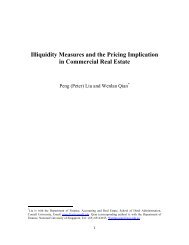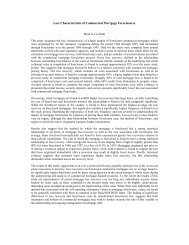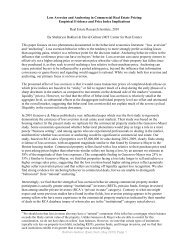Commercial Mortgage Delinquency, Foreclosure and Reinstatement
Commercial Mortgage Delinquency, Foreclosure and Reinstatement
Commercial Mortgage Delinquency, Foreclosure and Reinstatement
You also want an ePaper? Increase the reach of your titles
YUMPU automatically turns print PDFs into web optimized ePapers that Google loves.
To derive the excess returns, the return on a 1-month T-bill is deducted from the GLI.The resulting excess commercial mortgage series is plotted in Figure 1, against the excess returnson a BAA-rated, intermediate-term corporate bond. Note that the duration for the commercialmortgage series varies between 3.5 <strong>and</strong> 7.0 years (based on the true holdings of the ACLIsubmitting lenders), so it is comparable to an intermediate term bond in terms of duration.The macroeconomic variables used in the multiple factor model estimation aresummarized in Table 1. The factors correspond to the factors used by FF <strong>and</strong> Ling <strong>and</strong> Naranjo(1997). The size factor <strong>and</strong> the book equity to market equity factor were obtained from KennethFrench’s online data library, along with the returns on 25 stock portfolios, sorted by size <strong>and</strong>book-to-market equity 11 . Bond return series were obtained through DataStream from LehmanBrothers. These 8 series include indices for different ratings classes of corporate bonds (AAA,AA, A <strong>and</strong> BAA) <strong>and</strong> for two maturity lengths, long <strong>and</strong> intermediate. The REIT return series isan index compiled by the National Association of Real Estate Trusts <strong>and</strong> the index for whole,appraised real estate is from the National Council of Real Estate Investment Fiduciaries.Table 2 lists the descriptive statistics (quarterly) for selected return series, unsmoothedreal estate return series <strong>and</strong> all the factors. All return series shown are the excess form, where theone-month t-bill rate (quarterly) has been subtracted from the raw returns. The highest quarterlyexcess return of 4.40% is for the stock portfolio shown, which is the 13 th FF portfolio, which is ofmedium size <strong>and</strong> medium book equity to market equity. The lowest return of 0.47% is for theappraised real estate series. Note that this series, being appraisal based, is smooth <strong>and</strong>autocorrelated. Two methods have been used to unsmooth the real estate series, with details11 The French website elaborates on the construction of the 25 portfolios: “The portfolios, which areconstructed at the end of each June, are the intersections of 5 portfolios formed on size (market equity) <strong>and</strong>5 portfolios formed on the ratio of book equity to market equity. The size breakpoints for year t are theNYSE market equity quintiles at the end of June of t. Book-equity to market-equity for June of year t is thebook equity for the last fiscal year end in t-1 divided by the market equity for December of t-1. The ratiobook-equity to market-equity breakpoints are NYSE quintiles. The portfolios for July of year t to June ofyear t+1 include all NYSE, AMEX <strong>and</strong> NASDAQ stocks for which we have market equity data forDecember of t-1 <strong>and</strong> June of t, <strong>and</strong> positive book equity data for t-1.”9





